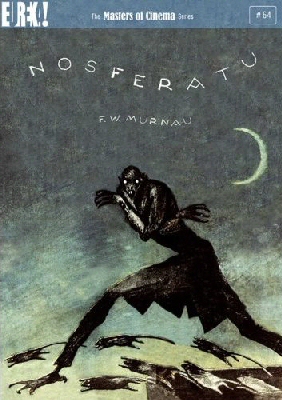
(a.k.a. NOSFERATU, EINE SYMPHONIE DES GRAUENS; NOSFERATU; NOSFERATU THE VAMPIRE; NOSFERATU: A SYMPHONY OF TERROR; TERROR OF DRACULA)
Surely in need of no introduction, this is the 1922 masterpiece of German cinema - widely regarded as the first horror film, and one of the all-time greats of celluloid expressionism. It's also the first (totally unauthorised) screen adaptation of Bram Stoker's "Dracula".
The film begins with young Hutter (Gustaf Von Wangenheim) and his wife Ellen (Greta Schroder), happy at home and very much in love. But that doesn't stop Hutter from getting extremely excited when his real estate agent boss Knock (Alexander Granach) tells him of a wealthy foreigner, Count Orlock (Max Schreck), who is looking to buy property in their small town.
Knock assigns Hutter to travel to the Count's castle and seal a deal in which the Count will buy a property opposite Hutter and Ellen's home.
Hutter rushes home to tell Ellen the good news. However, as he bounces round the house packing excitedly, Ellen doesn't take to the news too well. Upon realising this, Hutter arranges for her to stay with his good friend Harding while he's away.
And then he's off, at which point the film literally gets darker. What had started as a light story exemplified visually by the use of soft yellow-tinted sepia suddenly turns to a murky green tint onscreen as Hutter journeys into the world of the supernatural.
His journey first takes him to a tavern where he stops for food and drink. Upon telling the landlord where he is headed, the locals recoil in horror and tell him not to go near Orlock's castle. The landlord speaks of a werewolf that is said to roam the land surrounding the castle.
Undeterred, Hutter continues on his travels. It takes him an age to finally arrive at Orlock's castle (despite the use of fast-motion at times!), but when he finally does and he - and we - meet the Count, the film suddenly takes on a whole new slant and Schreck dominates it's remainder. It's at this point you fall in love with the film all over again and remember WHY it is such an undisputed classic ...
Eureka gave NOSFERATU the 2-disc treatment a few years back, so many may be thinking that there is really is little need to upgrade. Well, read on ...
First, there's the transfer, presented in the film's original 4:3 ratio. This newly restored transfer is absolutely gorgeous. For a film that is almost 90 years old, it's incredible that it's even remotely watchable, and Eureka's previous Special Edition was, I thought, a great effort. But this time around, images are cleaner, bright and sharper - the difference is immediately apparent. Honestly, you'll be stunned.
The film works a lot better here with it's original German intertitles too. They've been dramatically cleaned up and restored too, making the film at times look like a very modern production. This is a sterling job: hat's off to all concerned.
Optional English subtitles are available to complement the German intertitles. From the get-go, with the original German credits in attractive green-tinted hues, this is an altogether different experience to previous releases.
Another major difference with this new release is the inclusion of the original score, never before made available on DVD. It's scrubbed up superbly (and is offered in both mono and 5.1 mixes), adding ambience to a film already positively dripping with atmosphere. The original score makes the one used on Eureka's previous release seem unintentionally amusing in comparison.
Static menus include a scene-selection menu allowing access to the film via 18 chapters.
The only extra on disc 1 is a decent commentary track from historian R Dixon Smith and freelance writer Brad Stevens. It sounds like a cut-and-paste job to begin with, but they do start interacting as time goes on. There's an absolute wealth of information to be gleamed from this (how much will interest you is debatable). The pair seem to agree that although NOSFERATU is a masterpiece of expressionism, director F W Murnau should not be mislabelled as an expressionist - they go back to this point on several occasions.
Then it's over to disc 2, which continues to delight with a couple of very welcome bonus features.
The most significant of these is a 53-minute documentary about Murnau and the making of NOSFERATU. Entitled "The Language of Shadows", this is a genuinely interesting look into Murnau's background, from childhood and into his legendary films. Directed by Luciano Berriatua, this is clearly a labour of love.
The film features interviews with historians and people lucky enough to have met Murnau, plus family photographs, narration from Berriatua and even footage of locations used for NOSFERATU, as they appear today. Fascinating.
Finally, we get a 3-minute demonstration on how the movie's startling (and by all accounts very costly) restoration was achieved. Again, it's interesting stuff.
Both extras come with German audio and optional English subtitles.
An all-time classic, given a superlative makeover by Eureka. Upgrade!
Review by Stuart Willis
| Released by Eureka Entertainment |
| Region All - PAL |
| Rated 18 |
| Extras : |
| see main review |